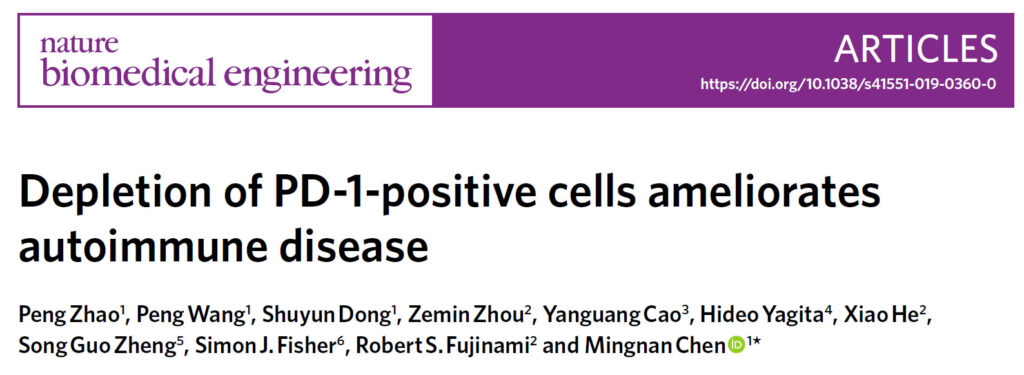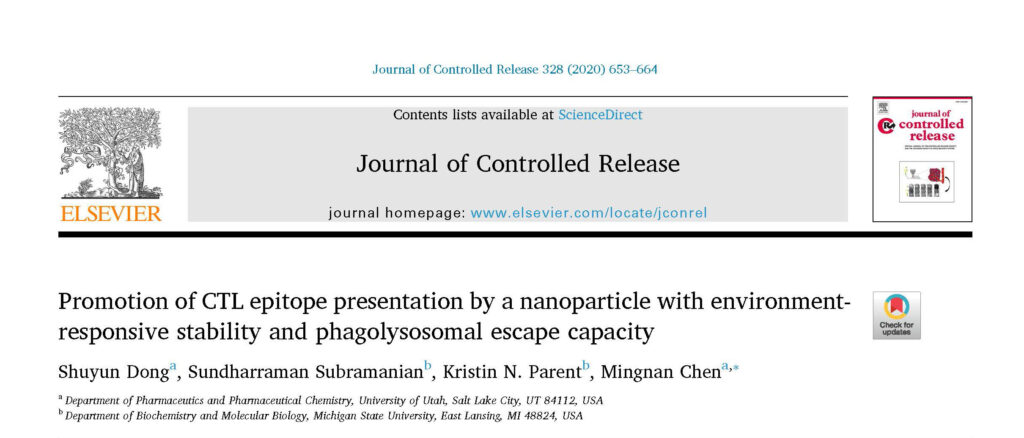Link to My Bibliography at The NCBI
Zhang T, Dong S, Zhai Y, Naatz L, Zhou Z, Chen M (2023). Diphtheria toxin-derived, anti-PD-1 immunotoxin, a potent and practical tool to selectively deplete PD-1+ cells. Protein Science. Volume 32, e4741. https://doi.org/10.1002/pro.4741
Here, we report an new anti-PD-1 immunotoxin that is comprised of the catalytic and translocation domains of the diphtheria toxin. The yield of this immunotoxin is ten times higher than the previously reported one, making it an appealing tool. Using this immunotoxin, we revealed roles of PD-1+ immune cells in autoimmune disorders such as type-1 diabetes and relapsing-remitting experimental autoimmune encephalomyelitis.
Zhai Y, Dong S, Li H, Zhang Y, Shami P, Chen M (2022). Antibody-mediated depletion of programmed death 1-positive (PD-1+) cells. J. Control Release. Volume 349, Pages 425-433. doi: 10.1016/j.jconrel.2022.07.010.
The article summarized the development and characterization of the first depleting antibody that target mouse programmed death-1 (PD-1) expressing cells. Since PD-1 expressing cells cancer be cancer cells or activated lymphocytes depending disease context, this antibody is a useful tool to investigate roles of PD-1 expressing cells in cancer, autoimmune diseases, and inflammation.
Zhai Y, Mossavi R, Chen M (2021). Immune checkpoints, a novel class of therapeutic targets of autoimmune diseases. An invited review for Frontiers in Immunology, section Immunological Tolerance and Regulation. Front. Immunol., 21 April 2021 | https://doi.org/10.3389/fimmu.2021.645699
Dong S, Subramanian S, Parent KN, Chen M (2020). Promotion of CTL epitope presentation by a nanoparticle with environment-responsive stability and phagolysosomal escape capacity. J Control Release. 2020 Dec 10;328:653-664. doi: 10.1016/j.jconrel.2020.09.033. PubMed PMID: 32961248; PubMed Central PMCID: PMC8729261.
Zhao P, Wang P, Dong S, Zhou Z, Cao Y, Yagita H, He X, Zheng S, Fisher S, Fujinami R, and Chen M (2019). Depletion of PD-1-positive cells ameliorates autoimmune disease. Nat Biomed Eng. 2019 Apr;3(4):292-305. doi: 10.1038/s41551-019-0360-0. Epub 2019 Mar 4. PubMed PMID: 30952980; PubMed Central PMCID: PMC6452906.
Wang P, Dong S, Zhao P, He X, and Chen M (2018). Direct loading of CTL epitopes onto MHC class I complexes on dendritic cell surface in vivo. Biomaterials, 182, 92-103
Wang P, Zhao P, Dong S, Xu T, He X, and Chen M (2018). An Albumin Binding Polypeptide both Targets Cytotoxic T Lymphocyte Vaccines to Lymph Nodes and Boosts Vaccine Presentation by Dendritic Cells. Theranostics, 8(1), 223-236
Dong S, Wang P, Zhao P, Chen M (2017). Direct Loading of iTEP-Delivered CTL Epitope onto MHC Class I Complexes on the Dendritic Cell Surface. Molecular Pharmaceutics, 14(10), 3312-3321
Zhao P, Atanackovic D, Dong S, Yagita H, He X, Chen M (2017). An Anti-Programmed Death-1 Antibody (αPD-1) Fusion Protein That Self-Assembles into a Multivalent and Functional αPD-1 Nanoparticle. Molecular Pharmaceutics, 14(5), 1494-1500.
Dong S, Xu T, Wang P, Zhao P, Chen M (2017). Engineering of a self-adjuvanted iTEP-delivered CTL vaccine. Acta Pharmacologica Sinica, 38(6), 914-923.
Zhao P, Xia G, Dong S, Jiang Z, & Chen, M. (2016) An iTEP-salinomycin nanoparticle that specifically and effectively inhibits metastases of 4T1 orthotopic breast tumors. Biomaterials. Vol93 p1-9.
Shi Q, Li Y, Bo S, Li X. Zhao P, Liu Q, Yang Z, Cong H, Deng H, Chen M, Chen S, Zhou X, Ding H, and Jiang Z. (2016) Discovery of a 19F MRI sensitive salinomycin derivative with high cytotoxicity towards cancer cells. Chemical Communications. Vol52 p5136-5139
Dong S, Xu T, Parent KN, & Chen M. (2016) A comparison study of iTEP nanoparticle-based CTL vaccine carriers revealed a surprise relationship between the stability and efficacy of the carriers. Theranostics. Vol. 6(5), p666-678. DOI: 10.7150/thno.14068
Cho S*, Dong S*, Parent KN, & Chen M. (2016). Immune-tolerant elastin-like polypeptides (iTEPs) and their application as CTL vaccine carriers. Journal of Drug Targeting. Vol.24, p328-339. PMID:26307138 (* Equal contributions)
Mastria EM*, Chen M*, McDaniel JR, Li X, Hyun J, Dewhirst MW, & Chilkoti A. (2015). Doxorubicin-conjugated polypeptide nanoparticles inhibit metastasis in two murine models of carcinoma. Journal of Controlled Release. Vol.8, p993-999. PMID:19898461 (* Equal contributions)
Zhang J, Kale V, & Chen M. (2015). Gene-Directed Enzyme Prodrug Therapy. The AAPS journal, 17(1), 102-110.
Zhao P, Dong S, Bhattacharyya J, and Chen M. (2014) iTEP Nanoparticle-Delivered Salinomycin Displays an Enhanced Toxicity to Cancer Stem Cells in Orthotopic Breast Tumors. Mol Pharm. Vol.11, p2703-2712. PMID: 24960465.
Chen M, McDaniel JR, MacKay JA, & Chilkoti A. (2011) Nanoscale Self-Assembly for Delivery of Therapeutics and Imaging Agents. Technology and innovation. Vol.13, p5-25. PMID: 24077873
Liu W, MacKay JA, Dreher MR, Chen M, McDaniel JR, … & Chilkoti A. (2010) Injectable intratumoral depot of thermally responsive polypeptide–radionuclide conjugates delays tumor progression in a mouse model. Journal of Controlled Release. Vol.144, p2-9. PMID: 20117157
MacKay JA*, Chen M*, Liu W, McDaniel J, Simnick A, Chilkoti A (2009). Self-assembling chimeric polypeptide-doxorubicin conjugate nanoparticles that abolish tumors after a single injection. Nature Materials. Vol.8, p993-999. (*Equal contributions)
Sadegh-Nasseri S, Chen M, Narayan K, Bouvier M (2008). The convergent roles of tapasin and HLA-DM in antigen presentation. Trends Immunol, 29, 141-147.
Chen M, Bouvier M (2007). Analysis of interactions in a tapasin/class I complex provides a mechanism for peptide selection. Recommended as a “Must Read” paper by Faculty of 1000 Biology. EMBO J, 26, 1681-1690.
Tan, Y., Chen, M., Li, Z., Mabuchi, K., & Bouvier, M. (2006). The calcium-and zinc-responsive regions of calreticulin reside strictly in the N-/C-domain.Biochimica et Biophysica Acta (BBA)-General Subjects, 1760(5), 745-753.
Chen, M., Stafford, W. F., Diedrich, G., Khan, A., & Bouvier, M. (2002). A characterization of the lumenal region of human tapasin reveals the presence of two structural domains. Biochemistry, 41(49), 14539-14545.



